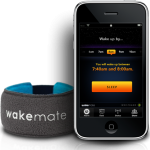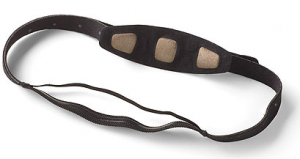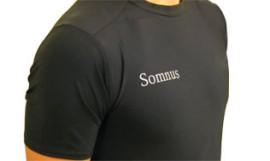Counting Sheep
It’s not a bad idea to know yourself and how you’re doing. Most of us do this to at least some extent (some more seriously than others), keeping tabs on weight or mood trends, exercise milestones, and so on. For obvious reasons, most of this is done while we’re awake and, you know, able to record — but lately, a lot of the emphasis has switched to the unconscious.
Curiously enough, the greater Boston area has managed to produce pretty much a fully accessorized outfit — minus the pants — of sleep-tracking devices. New Englanders, it seems, like not only to know their REM count, but they like to look damn good while they measure it. Here are a few of the latest and greatest sleep quantification gadgets that were (Dare I say it? Yes!) dreamed up around town.
 The WakeMate Wristband
The WakeMate Wristband
Created by a Yalie, a BC grad and a Harvard/MIT PhD, this is one of the simpler designs: a wristband hooks on to your wrist and tracks your movement through the night, feeding the activity information into your handy smartphone right beside you. In theory, you’re going to be at your least active during REM (when your limbs are paralyzed) and deep sleep stage, but will have increasing movement in lighter sleep to wakefulness (which is how the setup knows not to wake you up not in the middle of that incredible dream you’re dying to finish). The product and the idea started out here in Newton, though when the young innovators shipped out to the west coast for a 2009 stint at Silicon Valley’s most elite entrepreneur program, Y Combinator, they permanently relocated the business as well.
The Zeo Headband Based in Newton and invented by a host of Brown students, this takes the sophistication one step further with a techie-meets-tennis style headband and matching alarm clock. An EEG machine in miniature, the headband assesses the signature electrical activity generated by your neurons during the five stages of sleep. The night’s information is beamed back into the alarm clock, which — much like WakeMate — can then wake you at the most appropriate time, giving you and hour-by-hour sleep graph to boot. (One of our writers actually test-drove this headband last year as part of her pursuit of happiness. Her experience misjudging her sleep is actually not at all unusual: Most people in fact greatly underestimate how much they sleep, making insomnia something of a moving target for the doctors trying to treat it).
Based in Newton and invented by a host of Brown students, this takes the sophistication one step further with a techie-meets-tennis style headband and matching alarm clock. An EEG machine in miniature, the headband assesses the signature electrical activity generated by your neurons during the five stages of sleep. The night’s information is beamed back into the alarm clock, which — much like WakeMate — can then wake you at the most appropriate time, giving you and hour-by-hour sleep graph to boot. (One of our writers actually test-drove this headband last year as part of her pursuit of happiness. Her experience misjudging her sleep is actually not at all unusual: Most people in fact greatly underestimate how much they sleep, making insomnia something of a moving target for the doctors trying to treat it).
Easily the most fashionable of the three (or at least, the least eyebrow-raising), Nyx’s Somnus nightshirt just made its way into the media spotlight last week. Nyx is the sort of thing that happens when you pitch a problem (i.e., how to measure sleep without the crazy gadgetry that typically measures sleep) to a  crew of MIT engineers in a medical design class: it solves the problem with such breathtaking simplicity that you’re simply struck dumb that it hasn’t been done before. You see, it’s a shirt: a simple, basic short-sleeved Under Armour T-shirt pimped out with a set of electronic sensors so fine your fingertips can detect nothing more than than the insulating material coating it (which feels no different than any other T-shirt with a vinyl graphic). The sensors pick up on the motion and patterns of your breathing, and convey that information to a small recorder at your hip. The recorder can in turn be pulled off and hooked up to a computer to automatially upload the information to the Nyx website much as your iPod flips on iTunes when you plug it in (“So easy your grandma can use it,” is how one founder described their end goal). Wearers get to see a moment-by-moment analysis of their sleep, and the founders and advising sleep doctor get more data with which to bolster their device for when it faces the ultimate test for FDA approval for medical devices. The shirt’s not for sale yet though; the founding trio — Thomas Lipoma, Carson Darling, Pablo Bello — have only just revealed their prototype, and plan to try a beta launch later this year, with a possible public release in 2012.
crew of MIT engineers in a medical design class: it solves the problem with such breathtaking simplicity that you’re simply struck dumb that it hasn’t been done before. You see, it’s a shirt: a simple, basic short-sleeved Under Armour T-shirt pimped out with a set of electronic sensors so fine your fingertips can detect nothing more than than the insulating material coating it (which feels no different than any other T-shirt with a vinyl graphic). The sensors pick up on the motion and patterns of your breathing, and convey that information to a small recorder at your hip. The recorder can in turn be pulled off and hooked up to a computer to automatially upload the information to the Nyx website much as your iPod flips on iTunes when you plug it in (“So easy your grandma can use it,” is how one founder described their end goal). Wearers get to see a moment-by-moment analysis of their sleep, and the founders and advising sleep doctor get more data with which to bolster their device for when it faces the ultimate test for FDA approval for medical devices. The shirt’s not for sale yet though; the founding trio — Thomas Lipoma, Carson Darling, Pablo Bello — have only just revealed their prototype, and plan to try a beta launch later this year, with a possible public release in 2012.

